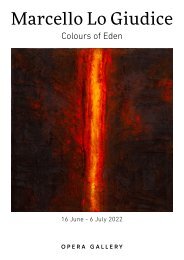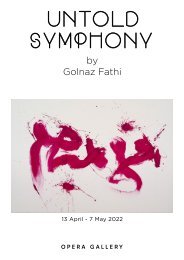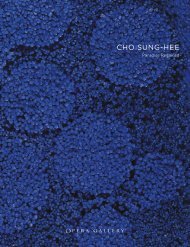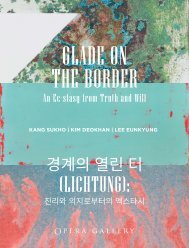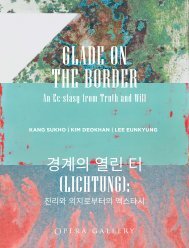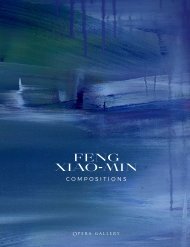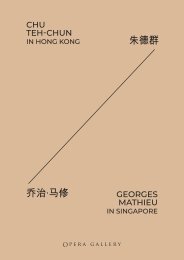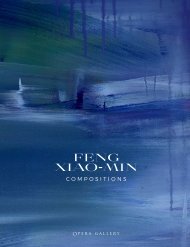Asian Art
Opera Gallery New York 15 - 30 March 2019
Opera Gallery New York
15 - 30 March 2019
Create successful ePaper yourself
Turn your PDF publications into a flip-book with our unique Google optimized e-Paper software.
ASIAN ART<br />
15 - 30 MARCH 2019
ASIAN ART<br />
15 - 30 MARCH 2019
ASIAN ART<br />
On the occasion of Asia Week New York, Opera Gallery presents an unprecedented exhibition<br />
featuring three major contemporary <strong>Asian</strong> artists: Zhuang Hong-Yi (China), Yoo Bong Sang and<br />
Cho Sung-Hee (Korea).<br />
Through the turmoil of the past century, generations of <strong>Asian</strong> artists went to study in Europe or the<br />
United States and in turn returned home with what they encountered abroad. Each of the three<br />
exhibited artists of this show share this experience. Their understanding of the world is nuanced<br />
and formed by these different vantage points, that are, in turn, reflected in their art. This selection<br />
of works represents the age of mechanical reproduction but also tries to transcend it. Each artist<br />
presented is a master of matter and manipulates it to elucidate an aspect of the world around us.<br />
These three artists shown in this exhibition stand out with their works incorporating unique and<br />
subtle textures, which help to create idiosyncratic, irregular and organically harmonious artworks.<br />
Whether using classical materials like oil paint, ink, ‘Hanji’ (made from mulberry tree pulp) and rice<br />
paper or less traditional, industrial materials such as steel nails, metal or wood, these creations<br />
are generally marked by a calm sense of minimalist clarity.<br />
Zhuang Hong-Yi is best known for his lush, layered “flowerbed” paintings created by folding<br />
countless pieces of painted rice paper into tiny blossoms. He creates his work with many traditional<br />
Chinese materials, including ink, rice paper, porcelain, and wood. Thus, his work represents two<br />
cultures brought together: China, home of his origins and education, that we find in the choice<br />
of materials, and the Western culture he developed from his stay in Europe, which led him to go<br />
beyond the confines of tradition in order to reinvent his work. His pieces reflect both the delicacy<br />
and subtlety of the Middle Kingdom and the power of expression, an important value of the Old<br />
Continent. The Chinese artist offers artworks rich in color, materiality, form and effect; vibrant and<br />
surprising pieces that change color with each of the viewer’s subtle movement.<br />
For Yoo Bong Sang, the confrontation is more brutal, and yet the materials he uses have<br />
more in common with each other: nails, wood and aluminium are combined to unique effect.<br />
These materials and the tools and methods of construction were traditionally designed to erect<br />
functional structures; here they are diverted to create a contradictory space for contemplation. A<br />
metamorphosis takes place, the materials no longer need ‘to do’, but ‘to be’. In partial contrast to<br />
artists who reference or draw specifically from the characteristics of nature, Yoo Bong Sang also<br />
focuses on civilization and human society, by representing the scenic with meditative patience,<br />
by repeatedly nailing thousands of pins into a support board, enduring hours of labour. His work<br />
becomes a metaphor for the power of civilization’s fight against nature through labour.<br />
Cho Sung-Hee delivers depth and density by cutting Hanji into rounded shapes, like petals, and<br />
accumulating them onto a canvas surface. Her work is about reflecting her own experience and<br />
initiating a dialogue between techniques from different places and periods – Korean Hanji paper,<br />
originally intended for India ink, and oil paint intended for canvas or board – and allowing the<br />
materials to occupy the place they are entitled to, while welcoming the other. It is a true delight<br />
to watch these two disparate natures combine to create works that are both unexpected and<br />
harmonious.<br />
Gilles Dyan<br />
Chairman & Founder<br />
Opera Gallery Group<br />
Gregory Lahmi<br />
Director<br />
Opera Gallery New York<br />
4<br />
5
ZHUANG Hong-Yi<br />
ZHUANG Hong-Yi is a Chinese artist, born in Sichuan province<br />
in 1962. He studied at the Sichuan Fine <strong>Art</strong>s Institute in China<br />
and the Academy Minerva in the Netherlands. Since the early<br />
1990s, he has been living and working between the Netherlands<br />
and Beijing.<br />
Zhuang has worked with a variety of materials and media,<br />
inspired by both his <strong>Asian</strong> background and his knowledge of<br />
European culture. He is best known for his “flowerbed” paintings<br />
created by folding countless pieces of painted rice paper into<br />
tiny blossoms. His work has been exhibited at the Kunsthal<br />
in Rotterdam, the Groninger Museum, where he had a solo<br />
show and the Stadsmuseum Zoetermeer in the Netherlands,<br />
the Sichuan Museum of Fine <strong>Art</strong> in China and was selected to<br />
represent China at the 55 th Venice Biennale.<br />
6<br />
7
17-V-006, 2017<br />
Collage of rice paper, acrylic, ink and varnish on canvas<br />
19.7 x 19.7 in - 50 x 50 cm<br />
front view<br />
left view<br />
right view<br />
8<br />
9
17-V-011, 2017<br />
Collage of rice paper, acrylic, ink and varnish on canvas<br />
35.4 x 35.4 in - 90 x 90 cm<br />
front view<br />
left view<br />
right view<br />
10<br />
11
B19-A012, 2019<br />
Collage of rice paper, acrylic, ink and varnish on canvas<br />
ø 74.8 in - 190 cm<br />
front view<br />
left view<br />
right view<br />
12<br />
13
18-X-031, 2019<br />
Collage of rice paper, acrylic, ink and varnish on canvas<br />
37.4 x 78.7 in - 95 x 200 cm<br />
front view<br />
14<br />
left view<br />
right view<br />
15
YOO Bong Sang<br />
YOO Bong Sang was born in 1960 in South Korea, where he grew up<br />
and graduated in 1987 with a degree in Fine <strong>Art</strong>s form the National<br />
University of Seoul. He decided to go to France, where he lived for<br />
twenty years before moving back to his homeland in 2008. A range<br />
of artistic experiences, particularly with photography, led the artist to<br />
question how pixels constitute an image. He chose the simple steel nail<br />
as a means to pursue his research, using it to conduct and reveal light.<br />
Carefully hammered into wood panels, the nails create shadows and<br />
reflections that reveal landscapes of forests, architecture or figures. His<br />
works require careful lighting on the surface, revealing itself as the viewer<br />
changes his or her position. Yoo Bong Sang was awarded the Pollock-<br />
Krasner Foundation Grant in 2001 and his works have been included<br />
in numerous exhibitions in Korea, Europe and the United States,<br />
particularly at the Fondazione Mudima in Milan, the Young Eun Museum<br />
of Contemporary <strong>Art</strong> in Gyeonggi, and at the Busan Museum of <strong>Art</strong>.<br />
16<br />
17
JJ20190214d, 2019<br />
Headless pins and acrylic on wood panel<br />
59.1 x 78.7 in - 150 x 200 cm<br />
detail<br />
18<br />
19
ST20190120, 2019<br />
Headless pins and acrylic on wood panel<br />
23.6 x 59.1 in - 60 x 150 cm<br />
20<br />
21
JJ20190215, 2019<br />
Headless pins and acrylic on wood panel<br />
59.1 x 39.4 in - 150 x 100 cm<br />
22<br />
23
NY20190125, 2019<br />
Headless pins and acrylic on wood panel<br />
23.6 x 47.2 in - 60 x 120 cm<br />
24<br />
25
E20190106, 2019<br />
Headless pins and acrylic on wood panel<br />
23.6 x 47.2 in - 60 x 120 cm<br />
26<br />
27
CHO Sung-Hee<br />
CHO Sung-Hee was born in 1949 in South Korea. In the constructing<br />
the surface of her works, Cho Sung-Hee uses a collage method in<br />
which many circles are hand-cut or gently torn from traditional Hanji<br />
paper, then layered with oil paint and placed one atop another. Cho<br />
Sung-Hee successfully combines traditional Korean sensibility with her<br />
unique vision and personal narrative. Her works explore the complex<br />
relationship between color and texture through a labour intensive, timeconsuming<br />
process.<br />
Her works have been exhibited and are collected in various prestigious<br />
private and public institutions including the Museum of Contemporary<br />
<strong>Art</strong> in Seoul, the Sejong <strong>Art</strong> Centre in Seoul, the Telentine <strong>Art</strong> Centre in<br />
Chicago, the Los Angeles Korea Cultural Service or the New York Korea<br />
Cultural Service.<br />
28<br />
29
Work C, 2013<br />
Hanji paper with oil on canvas<br />
63.9 x 51.3 in - 162.2 x 130.3 cm<br />
30<br />
31
Happy Blossom, 2018<br />
Hanji paper with oil on canvas<br />
89.5 x 71.6 in - 227.3 x 181.8 cm<br />
32<br />
33
Red Blossom, 2018<br />
Hanji paper with oil on canvas<br />
89.5 x 71.6 in - 227.3 x 181.8 cm<br />
34<br />
35
Published by Opera Gallery New York to coincide with exhibition <strong>Asian</strong> <strong>Art</strong>, 15 - 30 March 2019.<br />
All rights reserved. Except for the purposes of review, no part of this book may be reproduced, stored in a<br />
retrieval system, or transmitted, in any form or by any means, electronic, mechanical, photocopying, recording or<br />
otherwise, without the prior permission of the publishers.<br />
791 Madison Avenue New York, NY 10065<br />
+ 1 646 707 3299 | nyc@operagallery.com operagallery.com
operagallery.com






